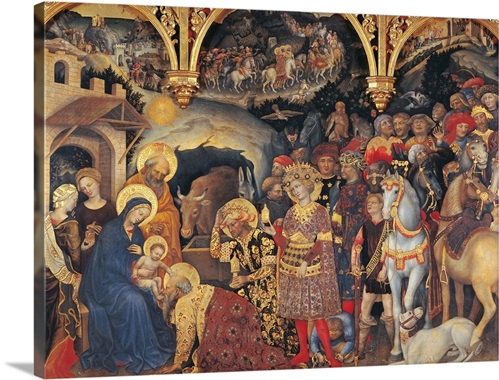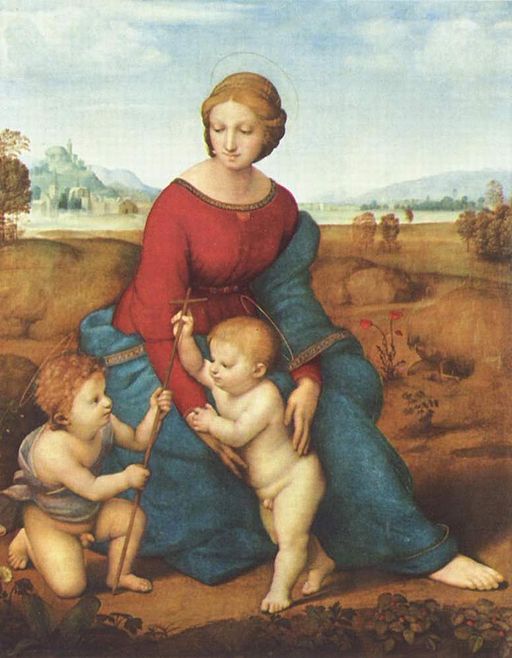St. Mark's Gospel, which is generally reckoned to be the earliest, does not mention the Nativity at all, but instead opens with Jesus meeting John the Baptist. St. John's Gospel, which is quite unlike the others in general character, equally ignores the Nativity. Instead John opens with the mighty passage (traditionally read at the conclusion of the service by the senior man present), starting "In the beginning was the Word", which seems to me to resonate more of Neoplatonism or Gnosticism than of simple Christianity. This leaves us with just Matthew and Luke to describe the Nativity; and they tell completely different stories. Their stories have been combined in Christmas readings, but certain parts are simply omitted. It is often pointed out, of course, that neither Matthew nor Luke give us any reason to think that the Nativity took place in late December. But the winter solstice is an obvious time of year for the God-King to be born.
Luke's acount of the nativity is best known. He was a gifted story-teller, and it is from Luke that we have the appearance of the Angel Gabriel to Mary, the jorney to Bethlehem for the census, the birth in a manger, "Because there was no room at the inn", and the shepherds summoned by an angel to worship the baby Jesus. But Luke's full account is actually much more complex, with other, less familiar, details.
Luke begins with the appearance of the angel Gabriel to Zecheriah, a priest. He and his wife Elizabeth, described as an elderly couple, have no children, but Gabriel announces that Elizabeth will soon bear a child: the future John the Baptist. Only after this, "in the sixth month", does Gabriel appear to Mary in the well-known scene where the future birth of Jesus Christ is announced. Mary then goes to meet Elizabeth, who is her cousin, and together they sing praises to God. The chapter end with the birth of John, which inspires a prophecy from Zecheriah.
It is in Book 2 that we have the "decree from Caesar Augustus that all the world should be taxed", Jospeh and Mary's journey from Nazareth to Bethlehem, the baby in the manger, and the coming of the shepherds. Luke then tells us that eight days later the infant Jesus was circumcised, and then presented in the Temple, with an appropriate sacrifice (a pair of turtle doves or young pigeons was usual, we are told); and the appearance of the baby inspires two pious old folks, Simeon and Anna, to utter prophesies. In Book three we pass to the work of John the Baptist and the bginning of Christ's ministry. Later in the chapter we have a genealogy of Jesus: son to father, through David, Abraham and Noah, all the way to Adam.
St. Matthew opens with a genealogy, father to son, from Abraham to Joseph, which is completely different from Luke's. There is not even an agreement on the name of Joseph's father! (In any case, we might wonder what the point of these genealogies is, since Luke and Matthew both insist that Joseph was not the biological father of Jesus. *See footnote). Matthew's story of the nativity involves the wicked King Herod, the wise men with their gifts, and the flight into Egypt to escape the slaughter of the children. But Matthew begins with Joseph, whilst betrothed to Mary, realising that she is pregnant, and deciding to end the marriage contract. He is deterred from this when an angel (not named) appears to him in a dream, and tells him that the child has been conceived by the Holy Spirit, in accordance with a prophecy.
Chapter two begins with the birth of Jesus in Bethlehem (with no mention of a manger, or reason for the family being there), and the appearance of the wise men (the Magi) to King Herod. They seek the newborn King of the Jews, for they have "seen his star in the East". Herod calls his scholars, who tell him that, according to a prophecy, the Christ child will be born in Bethlehem. The wise men go there, and the star stops over the place of birth. They present their famous and symbolic gifts; but are then warned in a dream not to return to Herod, and make their way home. Next, Joseph is warned, once again in a dream, to flee with the Holy Family to Egypt, thus escaping Herod's enraged massacre of all the babies in Bethlehem. It is only after Herod's death that Joseph is told (yet another dream) that it is now safe to return, and he goes to live, not in Judea, but in Nazareth; despite to suggestion that he had previously lived there. In chapter three we pass to John the Baptist and the start of Christ's ministry. It is a little odd that Luke, who is believed to be a Greek, mentions Jesus's circumcision and presentation in the Temple; whereas Matthew, who is supposed to be a Jew, does not. Or perhaps to a Jew they were too obvious to be worth mentioning?
It can be seen that these two accounts have practically nothing in common save for two points: firstly that Jesus was born in Bethlehem, and secondly, that he grew up in Nazareth, in Galilee, which is a long distance away to the north. (One way of accounting for the obvious discrepancies is the tradition that the Magi only arrived in Bethlehem several days after the birth, hence "the twelve days of Christmas") Also, the gospel accounts, especially Matthew's, have been much embroidered by later additions. He does not even tell us how many wise men there were: the tradition that they were is only a deduction from the fact that they presented three gifts. At no point are they called Kings: the New English Bible calls the astrologers! In the Middle Ages they were provided with names, and sometimes they were depicted as, respectively, a European, an Arab and a Negro, to symbolise the three continents of Europe, Asia and Africa cknowledging Christ. And since Matthew nowhere mentions a stable or a manger, paintings showing magnificently-dressed monarchs with vast trains of attendants kneeling before the infant Jesus in a rickety old stable, although gorgeous and dramatic, lack any Biblical basis.
 Nor, for that matter, is there any basis for the charming pictures of an ox and an ass looking down on the baby Jesus: these animals are nowhere mentioned.
Nor, for that matter, is there any basis for the charming pictures of an ox and an ass looking down on the baby Jesus: these animals are nowhere mentioned.We are told practically nothing about Joseph, except that he is descended from King David (by two incompatible genealogies). The tradition that he was much older than Mary is no more than a tradition; nor is there any reference in the nativity stories to him being a carpenter. But there is no reason why Jesus should not himself have been a carpenter before embarking on his ministry: it was quite common in the Jewish world for rabbis to come from humble origins and support themselves by everyday trades.
Both Matthew and Luke make an attempt to place a date on the nativity. King Herod plays an important part in Matthew's story, and Luke also places the story of Zechariah in the reign of Herod; though he confuses the picture by putting the census "when Quirinius was governor of Syria", which suggests a date as late as AD 6. He then says Jesus began his ministry "in the fifteenth year of the Emperor Tiberius": that is, AD 28 or 29. But this presents another problem, because in the Roman dating Herod died in 4 BC! This difficulty came to be realised in later centuries, which is why Bishop Ussher famously dated the creation of the world in 4004 BC rather than simply 4000; in other words, four thousand years before the birth of Christ.
When examining these different accounts, we should bear in mind the lack of any surviving independent evidence. Very few documents survive from the Ancient World, and states then were not run bureaucratically: they did not compile information just for its own sake. Historians in Greek and Roman times did not approach their work with the degree of rigorous research and evaluation that would be expected of a modern PhD thesis. The great Greek historian Thucydides tells us that he did not attempt accurate reporting of speeches, but instead tried "to have speakers say what, im my opinion, was called for by each situation". As R. G. Collingwood put it, "We start from the wrong premise by assuming that Greeks and Romans looked upon the study and writing of history essentially as we do". The same assessment can be made of the gospel writers.
Footnote:
A Jewish friend once told me that, for an orthodox Jew, it was a horribly blasphemous thought that God should come down to earth and beget a child on a human woman. The Greek and Roman gods, of course, were doing this all the time.
I remember a radio discussion about the Nativity between A. N. Wilson and a bishop. Wilson asked, "Look here, bishop: do you believe these things actually happened?" The bishop started talking about allegory and metaphor, but Wilson cut him short, saying, "Then you don't!" To my mind, Wilson had easily won this exchange, yet the studio audience gave much greater applause to the bishop!



















